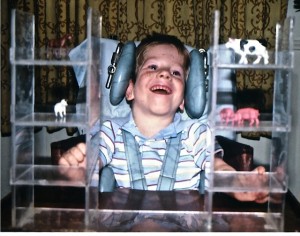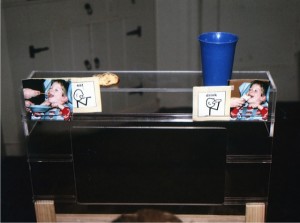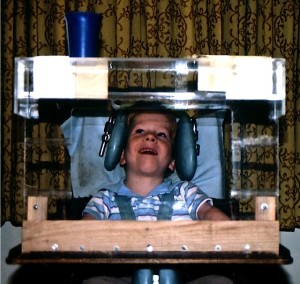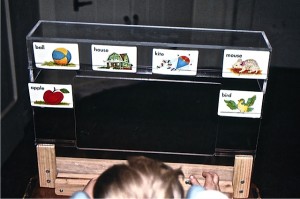Derek’s expressive communication was quite challenging for people to understand, more so than other sons I have shared about in previous posts. Although Ben, Alan, and Sean all have cerebral palsy and are non-ambulatory and nonspeaking, they have a bit more control over their physical movements and head control than Derek did. This allows them more selection of communication devices to express their wants and needs. They all use body language, facial expressions, and eye gaze in addition to AAC devices.
Derek was never able to access high-tech devices due to his limited physical control. He was never able to use pictures on his wheelchair tray because there was no way he could physically point to the pictures, and his line of vision was upward; he was not able to fix his eyes on lower things when seated in his wheelchair. To express himself, he depended primarily on body language and facial expressions, but one needed to know how to read and understand his movements to get an idea of what he was communicating. For example, his body would stiffen and this could mean a variety of things: discomfort, excitement, or dislike to mention a few. The “listener” would need to scan the environment for clues as to what he might want to communicate and then ask him YES/NO questions through ASL to clarify. Likewise, with his facial expressions, one expression could have various meanings.
Derek’s YES/NO responses were clear to me. I could detect a slight rise of his eyebrows, a broad smile, a grin, or sense of excitement for his YES answers. For his NO answers, there was a pout or turn of his head away or to the side and one other expression I can’t even describe. It was perhaps an expression we mutually agreed upon that meant NO. I began to recognize these idiosynchrasies at a fairly young age.
For more clear communication, “eye gaze” was Derek’s strongest strategy for self-expression. Eye gaze is when a person uses his eyes to direct attention to another person. This strategy is not always obvious. Derek’s eye gaze was clear to me but for others, they needed to understand and become familiar with his eye movements.
As mentioned in my book, DEREK, I did various tracking exercises and games with him to help strengthen his eye movements. Once he developed better control over his eyes and had a wheelchair, I made an e-tran from plexiglas.  It could be bolted on his wheelchair tray for language lessons. As you can see, this e-tran had shelves and boxes where we could place objects. The center was left open so Derek could see my signs more clearly than if there was a solid middle. In this photo, I was asking Derek to identify the “cow”. You can see that his eyes are focused on the cow. We began with two objects and gradually increased to four and six as he learned to be consistent with his eye gaze.
It could be bolted on his wheelchair tray for language lessons. As you can see, this e-tran had shelves and boxes where we could place objects. The center was left open so Derek could see my signs more clearly than if there was a solid middle. In this photo, I was asking Derek to identify the “cow”. You can see that his eyes are focused on the cow. We began with two objects and gradually increased to four and six as he learned to be consistent with his eye gaze.
 When I felt Derek was ready to move on to a bit higher level of self-expression through eye-gaze, I made another type of e-tran. This had a shelf on the top and a space where I could tape pictures that coincided with the objects. This is what it looks like from Derek’s view. I once again left the center open so he could see my signs. With this setup I could begin asking him if he wanted a drink or if he wanted something to eat. This is the same e-tran from the opposite side and how it looks to the person Derek is communicating with.
When I felt Derek was ready to move on to a bit higher level of self-expression through eye-gaze, I made another type of e-tran. This had a shelf on the top and a space where I could tape pictures that coincided with the objects. This is what it looks like from Derek’s view. I once again left the center open so he could see my signs. With this setup I could begin asking him if he wanted a drink or if he wanted something to eat. This is the same e-tran from the opposite side and how it looks to the person Derek is communicating with. 
As Derek’s accuracy using eye gaze and cognition improved, he was able to advance from using objects to using pictures with words and eventually to words only for which I do not have a photo. Securing the pictures and icons to the e-tran with tape was not the greatest idea. I wasn’t into using Velcro at that time either. I did find a small plastic trough that I was able to glue to the e-tran. It worked great with the pictures and didn’t leave sticky residue on things.
These e-trans were bulky and cumbersome to put on and take off of his wheelchair tray. They weren’t the answer to fluent, in-depth conversation, but the use of the e-trans did allow us to have a much better idea of what Derek understood in the educational setting. For all practical purposes, our daily communication was built on Derek using eye gaze in the present environment. I would follow his gaze and then ask him questions to make certain I understood what he wanted to communicate. These are examples of what were successful for Derek about twenty-five years ago.
The key is working with each individual and finding or modifying your approach to accommodate their needs. The websites below provide more information on eye tracking and eye gaze communication that might be of interest to you.
Today, there are a myriad of options for providing more fluid communication with our special needs children and adults. What works for you? Please share your innovations and stories.
Communicate With The World Using The Power of Your Eyes



